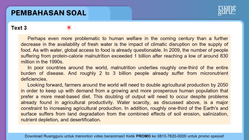Iklan
Pertanyaan
The following text is for question 83 - 86
Text 3
Perhaps even more problematic to human welfare in the coming century than a further decrease in the availability of fresh water is the impact of climatic disruption on the supply of food. As with water, global access to food is already questionable. In 2009, the number of people suffering from protein-calorie malnutrition exceeded 1 billion after reaching a low of around 830 million in the 1990s.
In poor countries around the world, malnutrition underlies roughly one-third of the entire burden of disease. And roughly 2 to 3 billion people already suffer from micronutrient deficiencies.
Looking forward, farmers around the world will need to double agricultural production by 2050 in order to keep up with demand from a growing and more prosperous human population that prefer a more meat-based diet. This doubling of output will need to occur despite problems already found in agricultural productivity. Water scarcity, as discussed above, is a major constraint to increasing agricultural production. In addition, roughly one-third of the Earth's and surface suffers from land degradation from the combined effects of soil erosion, salinization, nutrient depletion, and desertification.
Finally, the rise of the biofuels industry is generating enormous demand for grain. By increasing grain demand and, as a consequence, demand for arable land and irrigation, growing grains as biofuels feedstock will be deemed more important than human food needs. Thus, growing grains for biofuel needs an immediate banning action.
Amid rapidly rising demand for food, increasing environmental pressures on food production, and growing human malnutrition, climate change additionally compromises both agricultural yields and the nutritional quality of the crops produced. Agricultural productivity is well known to be sensitive to changes in growing season temperatures. Observational, longitudinal, and modeling studies all confirm that a 1 oc rise in temperature corresponds to roughly a 1 Oo/o reduction in yield of the major grains. As temperature rise 2 - 6°C over the next century, the reduction in agricultural yield will depend, in part, on our capacity to adapt and in part, on how temperature variability changes; but, in general, yields are expected to drop.
(Diadaptasi dari http://www.ncbi.nlm.nih.gov/pmc/articles/PMC 3042309/)
The passage implies that ____.
The passage implies that ____.
Farmers around the world will need to multiply agricultural yields by 2050 due to their high demand
A bigger problem about human welfare in the next century is decrease in the supply of fresh water.
In the end, the rise of the biofuels industry is leading to enormous supply and demand for crops
Increasing environmental pressures on food production compromises both agricultural yields and the nutritional quality of the crops produced
With the rise of the temperature each year, human beings will eat food of lower quality than today
Iklan
N. Puspita
Master Teacher
3
0.0 (0 rating)
Iklan
Pertanyaan serupa
RUANGGURU HQ
Jl. Dr. Saharjo No.161, Manggarai Selatan, Tebet, Kota Jakarta Selatan, Daerah Khusus Ibukota Jakarta 12860
Produk Ruangguru
Bantuan & Panduan
Hubungi Kami
©2025 Ruangguru. All Rights Reserved PT. Ruang Raya Indonesia

















